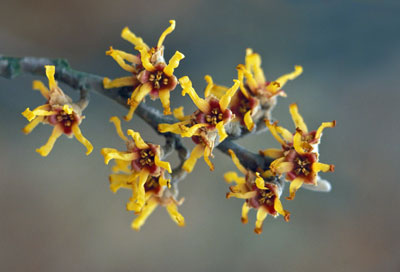
By Dan Zarlenga, Missouri Department of Conservation
Photo caption: Ozark witch-hazel blossoms, as if by magic, in the middle of winter.
Photo by Jim Rathert, Missouri Department of Conservation
Leave it up to a plant called witch-hazel to bloom in the middle of winter, cure ailments, and find water by magic Ozark witch-hazel is a shrub that grows mostly in rocky areas, whether they be rock streambeds or at the base of a rock-strewn slope. Common originally in the Ozark highlands of southern Missouri, it is now often grown by humans throughout the state. This witch-hazel has an unusual appearance, not unlike a plant that a witch might grow for use in a magic potion. Its twigs are stout, light to reddish-brown or gray, and covered densely in velvet-like hair. The flowers actually bloom during winter, starting as early as late January, and through February. The odd-looking petals tend to be orange or dark red, even yellow, and radiate outward from dark centers like four rays of a tiny starburst. One might think it impossible for flowers to be at all productive during winter, when pollinators are dormant.
Ozark witch-hazel, however, tends to time its blooming when there are those few random, warm days in winter. Then, it’s almost as if it casts a magic spell that causes gnats, midges, and flies to arouse from their wintry sleep and do the witch-hazel’s pollination bidding. The plant’s flowers put out an intoxicating scent that attracts these insects in to quickly perform their work before the cold returns. As evocative is its name sounds, Ozark witch-hazel is not really named after the sorceresses of folklore.
Instead, it traces its name to the Middle English word “wyche”, which means bendable or pliable. This probably referred to the plant’s very flexible twigs described above. One of the magical powers attributed to witch-hazel twigs in legend is their ability to detect water. Practitioners of divining use them as dowsing rods to help find the best place to dig wells. Science may question the effectiveness of the technique, but there’s no doubt it adds to the mystique of a plant called witch-hazel. Witch-hazel is also popularly known for it’s special healing abilities. Extract made from twigs, bark and leaves of the plant is used for everything from shaving lotions to balms, to ointments for treating bruises, sprains, acne, insect bites, and other skin irritations. Witch-hazel extract contains chemicals called tannins that when applied to skin, can help reduce swelling, repair damaged skin, and fight bacteria. Witch-hazel is often employed to stop minor bleeding and is even taken by mouth for conditions ranging from diarrhea, colds, fever, and cancer. Perhaps witch-hazel is something of a magic potion, after all.
So, when you might think that there’s no magic left in the dead of winter, keep your eye out for Ozark witch-hazel. You could see some tiny, yellow-orange starbursts adding a dash of color to an otherwise drab landscape. Be careful though. They might cast a hypnotic spell on you, just like the insects that pollinate them.


